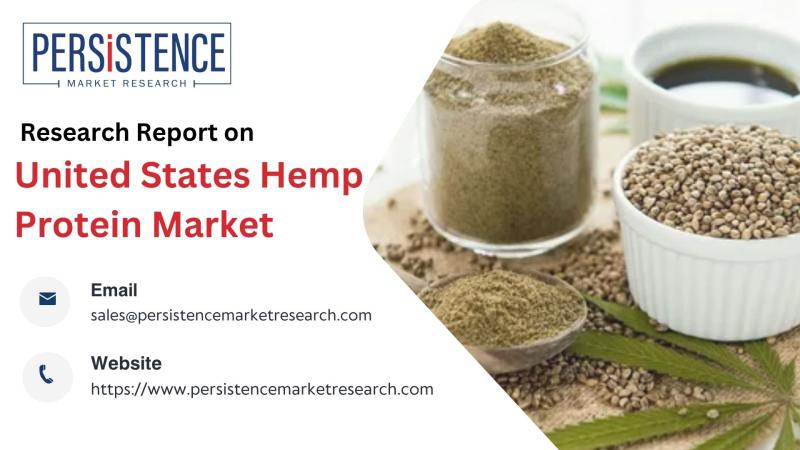[[{“value”:”
04-30-2025 01:22 PM CET | Food & Beverage
The United States hemp protein market is undergoing a transformative shift as consumer behavior evolves toward healthier, plant-based nutritional choices. The growing awareness around sustainability and the health benefits associated with plant-based proteins is propelling the popularity of hemp protein, particularly among younger demographics and health-conscious individuals. Hemp protein, known for its complete amino acid profile, digestibility, and presence of essential fatty acids, is gaining traction in various applications such as food, beverages, and supplements.
Get a Sample PDF Brochure of the Report (Use Corporate Email ID for a Quick Response):
https://www.persistencemarketresearch.com/samples/11983
The report on the United States Hemp Protein Market for the years 2019-2033 provides a comprehensive analysis of market trends, growth drivers, and key challenges shaping the industry. It includes detailed segmentation by end-use sectors such as food & beverages and supplements, examines regional consumption patterns, and highlights the evolving regulatory landscape. The study also profiles major market players, tracks recent developments, and offers data-backed forecasts on market size and volume, helping stakeholders make informed strategic decisions in a rapidly growing plant-based protein segment.
Key Highlights from the Report
➔ Hemp protein is being widely used in the development of clean-label, plant-based food products.
➔ The food and beverages segment dominates the market, followed by supplements.
➔ Western U.S. states hold the largest market share due to favorable regulatory frameworks.
➔ Consumers in their 20s and 30s are the most active adopters of hemp protein diets.
➔ Regulatory clarity, such as the GRAS status for hemp seeds, is encouraging product innovation.
➔ A growing preference for allergen-free, digestible protein sources fuels supplement applications.
Market Segmentation
The United States hemp protein market is segmented primarily by end-user applications into food and beverages and supplements. Within the food and beverages segment, sub-segments include bakery, beverages, and snacks. These products benefit from hemp protein’s neutral flavor and high nutritional value, making it an ideal additive in both sweet and savory foods. The supplements segment includes products targeting sports nutrition and elderly nutrition, capitalizing on hemp protein’s digestibility and hypoallergenic properties.
The food and beverages segment accounts for a substantial share of the market, attributed to the increasing demand for protein-enriched snacks and functional beverages. The supplement segment is witnessing the fastest growth, particularly within sports and performance nutrition, due to the rising awareness of hemp protein’s benefits in muscle recovery and overall wellness.
Regional Insights
Regionally, the Western United States leads in hemp protein adoption. States like California and Colorado have long championed plant-based food alternatives and hemp legalization, enabling the proliferation of hemp-based food and beverage products. In these states, both regulatory agencies and consumers are highly supportive of sustainable, clean-label, and vegan nutrition sources, bolstering the growth of hemp protein.
The Southern and Midwestern regions are also showing gradual uptake, with increasing consumer awareness and retail availability contributing to market expansion. Retail infrastructure in these areas is witnessing growth, supported by national-level distribution networks. The Northeastern region follows closely behind, characterized by a sophisticated urban consumer base that is gradually shifting toward wellness-focused food products.
Market Drivers
One of the primary drivers of the hemp protein market in the United States is the increasing consumer inclination toward plant-based and sustainable food sources. Millennials and Gen Z, in particular, are reshaping the nutrition industry by demanding clean, functional, and natural ingredients. The high digestibility, complete protein profile, and presence of essential fatty acids like omega-3 and omega-6 make hemp protein highly attractive to these consumers.
Additionally, favorable regulations such as the FDA’s GRAS status for hemp seed-derived ingredients provide manufacturers with confidence to innovate and expand their hemp protein offerings. Technological advancements in hemp seed cultivation and protein extraction processes are further enhancing product quality, shelf life, and versatility, thus attracting wider applications.
Market Restraints
Despite the promising growth, the market faces certain challenges. One of the major restraints is the lingering stigma associated with hemp due to its botanical association . Although hemp used for protein production contains negligible levels, consumer education is still required to overcome misconceptions.
Another challenge is the variability in regulatory acceptance across states, which can complicate supply chain logistics and create entry barriers for smaller players. The high cost of premium-quality hemp protein, compared to more established alternatives like soy and whey, may also deter price-sensitive consumers.
Market Opportunities
Emerging opportunities lie in the expansion of product offerings within the functional food and supplement markets. With rising incidences of lactose intolerance and soy allergies, hemp protein is becoming a preferred alternative due to its hypoallergenic and highly digestible nature. There is also growing potential in the personalized nutrition and sports nutrition segments, where demand for clean, performance-enhancing protein is high.
The development of hemp protein isolates, which offer higher purity and targeted nutritional benefits, presents an untapped avenue for manufacturers. Additionally, the integration of hemp protein in elder nutrition and medical nutrition products is likely to grow as the aging population in the U.S. increasingly adopts health supplements.
Frequently Asked Questions (FAQs)
◆ How big is the United States hemp protein market currently?
◆ What is the projected growth rate of the hemp protein market in the U.S.?
◆ Who are the key players in the United States hemp protein market?
◆ What are the major factors driving hemp protein demand across regions?
◆ Which region is estimated to dominate the hemp protein market during the forecast period?
Company Insights
• Axiom Foods Inc.
• Cooke Inc.
• ETChem
• Martin Bauer Group
• Tilray Inc.
Contact Us:
Persistence Market Research
G04 Golden Mile House, Clayponds Lane
Brentford, London, TW8 0GU UK
USA Phone: +1 646-878-6329
UK Phone: +44 203-837-5656
Email: sales@persistencemarketresearch.com
Web: https://www.persistencemarketresearch.com
About Persistence Market Research:
At Persistence Market Research, we specialize in creating research studies that serve as strategic tools for driving business growth. Established as a proprietary firm in 2012, we have evolved into a registered company in England and Wales in 2023 under the name Persistence Research & Consultancy Services Ltd. With a solid foundation, we have completed over 3600 custom and syndicate market research projects, and delivered more than 2700 projects for other leading market research companies’ clients.
Our approach combines traditional market research methods with modern tools to offer comprehensive research solutions. With a decade of experience, we pride ourselves on deriving actionable insights from data to help businesses stay ahead of the competition. Our client base spans multinational corporations, leading consulting firms, investment funds, and government departments. A significant portion of our sales comes from repeat clients, a testament to the value and trust we’ve built over the years.
This release was published on openPR.
“}]] The United States hemp protein market is undergoing a transformative shift as consumer behavior evolves toward healthier plant based nutritional choices The growing awareness around sustainability and the health benefits associated with plant based proteins is propelling the popularity of … Read More


